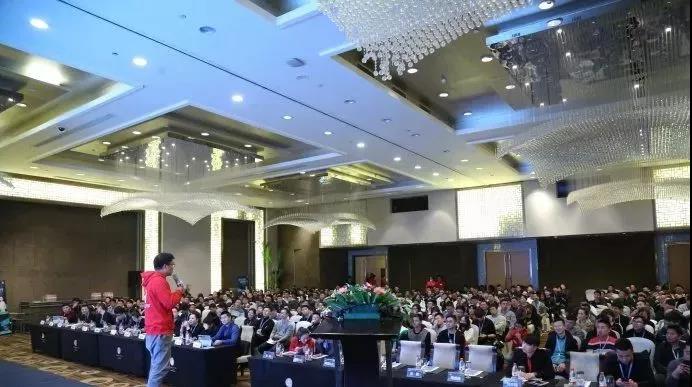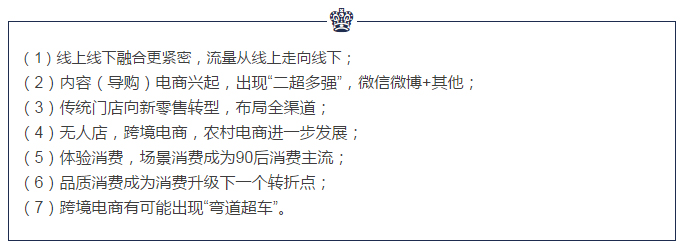Introduction: A few days ago, we held the last regular meeting of Laogao e-commerce club in 2017 at the Guofeng Hotel in Shanghai. The scene was full and the response was fierce. Given the limited time for speaking on stage at that time, I reorganized my speech that day.
I think China's e-commerce will focus on these 10 keywords in 2017. [In 2 minutes, you can understand the development history of e-commerce in 2017! 】

1. E-commerce + store merchants
I think many people, like me, think e-commerce is becoming more and more difficult to do. In fact, it is not that e-commerce is difficult to do, but it is just that it has returned to normal and the market is not as impetuous as before. With the saturation of smartphones, online traffic has basically reached the ceiling. Therefore, what everyone sees this year is that Alibaba, JD.com and other large-scale offline stores are being deployed, either in investment or in mergers and acquisitions or cooperation.
Simple e-commerce is no longer able to support Alibaba's stock price. Online traffic alone has risen, so offline layout is imperative.
2. Consumption upgrade
The day before yesterday, the Ministry of Commerce issued a statement saying that the "Consumption Upgrade Action Plan" will be fully launched next year. This is the key work measure proposed by the Ministry of Commerce in the next five years in the consumption field. It can be seen that the country attaches importance to the trend of consumption upgrading. I have also said on Weibo many times that the consumption upgrade in the e-commerce field in 2018 is mainly reflected in these aspects: 1. Brand upgrade; 2. Channel upgrade; 3. Category upgrade; 4. Marketing upgrade.
Today's consumer demand is becoming increasingly segmented, and they prefer small and brands around them. In the past, consumers believed in big brands, but now this sense of trust has been reduced by many millennials. They turn to pursue brands with more tone and mission; in the past, for fast-moving consumer goods, occupying the shelves of large retailers was a very wide "moat"; now, this "moat" is being filled by the ecology built by the Internet and e-commerce.
3. Social Sharing
Everyone knows that there is an app called Pinduoduo. Media reports that in March 2017, Pinduoduo already had 100 million paid users, with a monthly GMV of more than 4 billion. What is the size of 4 billion? This is more than many currently active apps. Pinduoduo rose from low prices and group buying, and was triggered through social media. Whether it is WeChat business or Pinduoduo, it fully proves that social e-commerce is rising.
Today we buy something, but searching is not the first choice. We trust more on the recommendations and sharing of acquaintances and on the evaluations of other netizens. Social sharing is increasingly becoming an indispensable part of connecting users and merchants.
4. Experience consumption
We are ushering in an era where consumers are extremely eager for a unique and immersive experience. Brands must upgrade the entire consumer experience to the extreme so that people can demonstrate their personal identity and taste. The high quality of the product itself, the detailed packaging experience and good content will become the key factors for whether consumers will buy the product. In the era of consumption upgrading, experience is becoming more and more important. Thematic experience is enough to change consumers' feelings about reality, Disneyland is the best example.
Enterprises must consciously use services as the stage and products as props to integrate consumers into it and create a unique experience so that enterprises can enhance their economic value.
5. New retail
If 2016 is the hottest new retail industry, 2017 is the first year of new retail. In the view of Gao Hongbing, vice president of Alibaba Group and director of Alibaba Research Institute, there are three major trends in new retail in 2018: (1) New retail promotes the upgrade of store experience; (2) New retail service providers will emerge in large numbers; (3) The degree of digitalization penetrates the upstream of the industry, and big data promotes supply-side structural reform.
From unmanned stores to drone delivery, new retail has entered the second half. Tencent negotiated with Yonghui Supermarket and Alibaba acquired Gao Xin Retail. The pattern of "three parties competing for destiny" has begun to emerge. At this point, after experiencing traditional department stores, chain supermarkets, e-commerce and other forms, the retail industry has faced a new update and iteration, and the prototype of the three-party new retail market structure such as Yonghui Supermarket, Alibaba Group and JD.com has begun to emerge.
6. Content shopping guide
At the Weibo Big V Summit in December this year, Weibo CEO Wang Gaofei said that in 2018, Weibo will fully focus on content shopping guide services, that is, fully launching content e-commerce. Join forces from all walks of life, experts, big Vs, etc. to jointly create a Weibo e-commerce ecosystem.
In the content e-commerce map, Weibo did not make any efforts in the early stage. WeChat official account, Rincai Mama, Mogujie Meilishu app, etc. have already begun to test the waters. My understanding of content e-commerce is to build trust thresholds based on content and achieve sales. Content e-commerce is a new traffic channel, a new way to maintain marketing methods for customers, and a new way to enhance fan stickiness. In the past, I left after searching, but now it is a good content that increases the user's stay time; in the macro environment of content-oriented trend, browsing and consumption, customers prefer to place orders. The platform has gone from extensive operation to refined operation; rules and traffic.
7. Globalization
Because the domestic traditional online shopping market has become saturated, as listed companies, JD.com and Alibaba have been deploying overseas markets in pursuit of economic benefits, and globalization has become the general trend. Any company, whether it wants to "go global" or not, needs to have a global mindset, put the company in the entire global market, and re-exploring its own competitive advantages and core values.
8. Rural e-commerce
Although Taobao proposed the "rural e-commerce" strategy in 2014, the result was heavy thunder and little rain. But this has not stopped the future development trend of rural e-commerce. I believe that rural e-commerce will present these four major business opportunities in the future:
1. Rural Finance: Finance is the best weapon that can open up the agricultural industrial chain. Through financial strategic layout, we can quickly strategic the market and win users' preferences;
2. Rural Logistics: Logistics has always been a pain point in rural e-commerce or rural markets. If logistics is not solved well, rural e-commerce will stop moving forward; 3. E-commerce training: Training is not the purpose. Through the output of skills, knowledge and concepts, the practical level and ability of rural youth in e-commerce have been improved, and a large number of talents and teams have been stored for Internet tycoons to deploy rural markets;
4. Agricultural product export: E-commerce is not e-commerce, and it is the key to enriching fellow villagers. The only way is to help the people sell agricultural products and let them make money.
9. Omnichannel
As an Internet company, all departments are trying to rely directly on end users, and the boundaries between marketing and products are becoming increasingly blurred. Marketing is products and content is advertising, which is the trend I can see. When Internet+ becomes the standard configuration for business, then for e-commerce, the next 10 years will be the 10 years of upgrading and iteration of omnichannel and industrial chains.
The rise of various apps such as Toutiao, WeChat public account, QQ space, Tencent Video, iQiyi, Kuaishou, Douyin... As users become more and more dispersed and time becomes more fragmented, omni-channel marketing has become inevitable. All companies must want users to get close to them, and they must do wherever they are.
10. Cross-border
If e-commerce still has a blue ocean, cross-border e-commerce must be one of them. At present, the main obstacles to cross-border e-commerce are: 1. National policies; 2. Integration of overseas supply chains and logistics; 3. Quality control of goods (authentic product guarantee); 4. Homogenization of competition; 5. Price advantage. In any case, this is the only industry that is not completely monopolized at present. When giants such as JD.com, Tmall, Jumei, NetEase, and Vipshop are all making plans, startups such as Miya, Xiaohongshu, Mitao, Darling, Yangwo, and Jackfruit are also called increasingly important forces in the market.
Having said so much, in fact, in summary, there are several main trends in e-commerce in 2018:

Thank you for your attention and support to Laogao E-commerce Club . Please indicate the source of the reprinting website www.shxuanming.net
Click to register to apply to join the well-known e-commerce network - Laogao E-commerce Club. Any merchants from all over the country, Tmall merchants, Taobao Crown Store, Jinguan Store, and other e-commerce platform merchants can apply to join!




![#Laogao E-commerce Newsletter# [E-commerce Morning News on April 29]](/update/1619658285l737802140.jpg)
![#Laogao E-commerce Newsletter# [E-commerce Evening News on September 2]](/update/1628762699l369066323.jpg)


 EN
EN CN
CN
